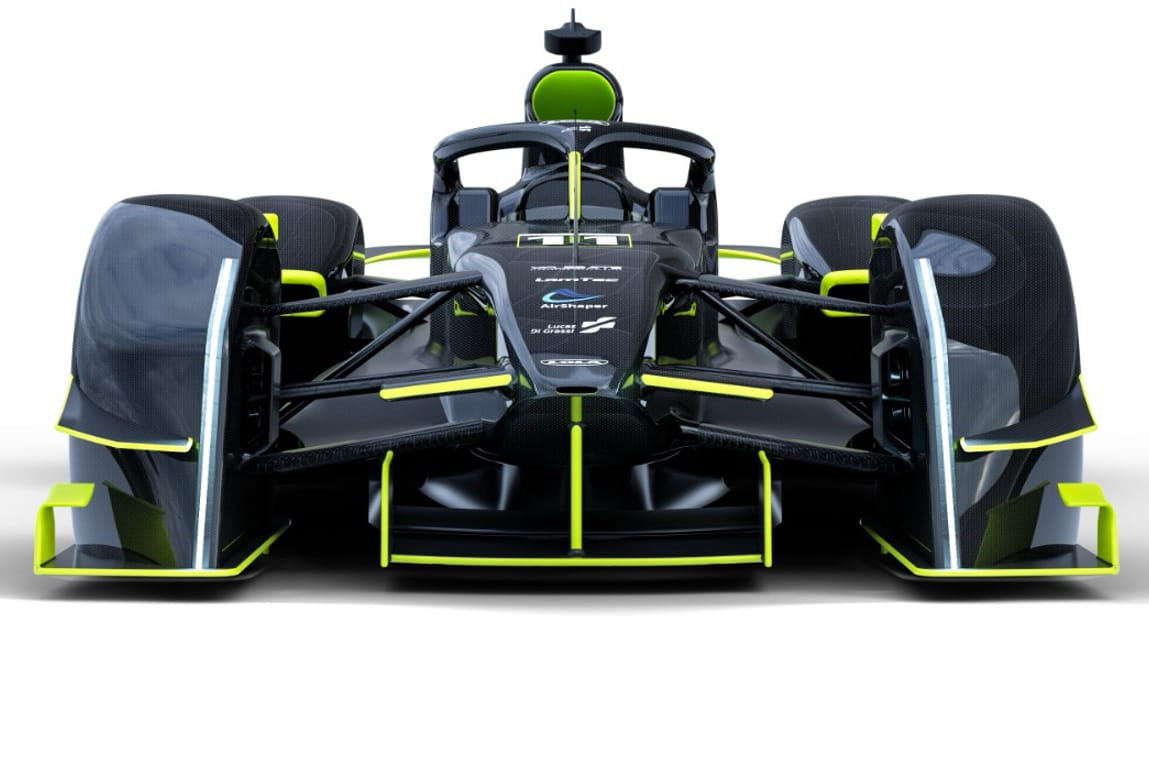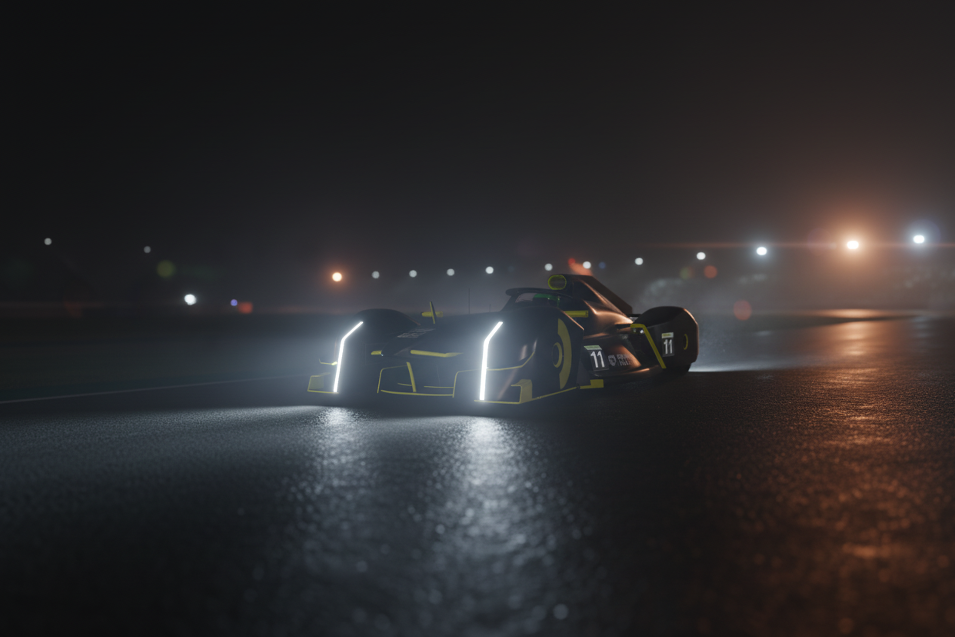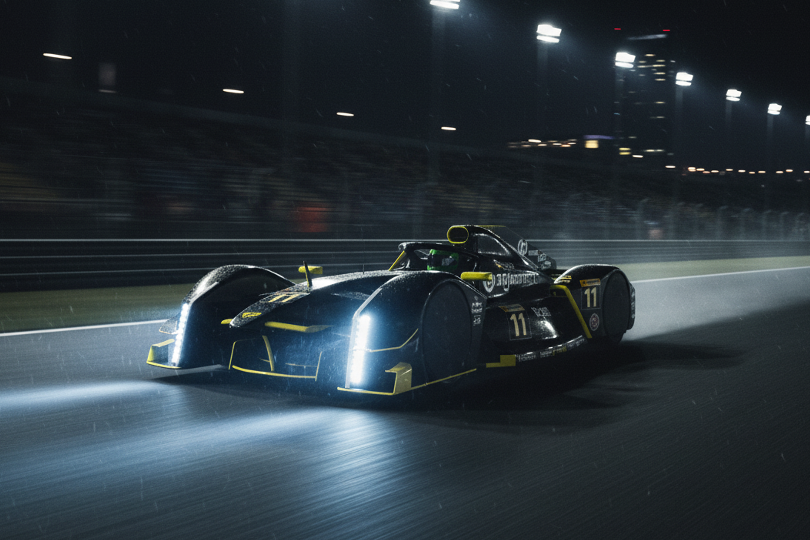A modern-day, electric-powered, Brabham BT46-like wonder that would be quicker than a Formula 1 car and also make the outrageous and spectacular McMurty Spéirling look tame.
That's the secret project that 2016-17 Formula E champion Lucas di Grassi has been working on for the past year, and its one he is determined to see go from a concept to a reality in the coming years, utilising some new design philosophical thinking that might just redefine how racing cars are conceived and created.
What drove di Grassi to undertake the project, which he has driven along with his Formula E employer Lola and also other industry proven suppliers, is simple: it is essentially to fact-check himself and stress-test his own curiosity on how fast an electric single-seater could go if given degrees of carte blanche from regulations.
There is an idiosyncratic vibe with di Grassi's own curiosity here too and its major part of the fun!
"You know me, right?" says di Grassi, with whom for 12 years this author has had numerous, fascinating discussions on motorsport and many other subjects.
"I often say, 'We should go that way, we should do this, we should do that' and everybody's very sceptical of the things I say, because they are meant to innovate and you need to think a little bit outside of the box.
"I wanted with this project to see if the numbers actually matched what I was saying, so I thought I'd design a car with the aim of being able to build a car that has the maximum performance possible."
The DGR-Lola concept

Di Grassi explains to The Race that the car is "basically an analogy of how combustion cars were designed, or how F1 rules are".
"The Gen3 Evo, with the four-wheel drive, is the first time there is something completely new, and it was positive," he adds.
"Another thing is that I wanted a modular car to be able to drive in different tracks, so we could go to the Nordschleife, Macau and so on.
"This design needs to be a verifiable truth, so for example, aerodynamic drag is the main variable. But what does this mean?
"It means that if the car had zero drag, it could almost do the Le Mans 24 Hours with a single battery.
"The main thing that dissipates energy is drag, and you cannot have the drag to zero, of course, but the main drag value that you can reduce drastically is the aero. A big chunk of the energy wasted is in aero. So, to make the electric car go longer, you need to reduce the drag."
The problem that Di Grassi was wrestling with was that when you reduce the drag, you reduce the downforce. This was a key feature of the DGR-Lola concept.
Also important was to avoid exotic or non-existing technology. As an example, di Grassi didn't want to use a solid state battery that will likely be ready in the next decade for motorsport.
"If we did things like this it would be too easy," rationalises di Grassi. "It needs to be realistic, right? And we also want to simplify non-essential engineering. Engineers, they love to engineer what they don't have, everyone knows this.
"They love to optimise stuff that shouldn't be there. So, we try keep it driver-centred, it needs to be a challenge for the driver."
Di Grassi likes a challenge and as a driver he was keen to ensure this was a core element, but he was also wary that "the technology we can take from the race car to the production car, so more manufacturers are interested, is very important".
The efficiency

How about the pursuit of performance and efficiency? That's been amplified by one part at the rear of the car.
"The fan is more efficient than a diffuser, that is more efficient than a wing, so it makes no sense to have wings if you want a very efficient car," he reckons.
"Pretty much all the downforce needs to come from the suction. But in this case we have a blown diffuser from the diffuser. So, I combine the two technologies into one. Why? Because it creates more downforce and it's more efficient.
"This car has both suction and a blown diffuser to create an extreme efficiency ratio that allows you to drive for a longer period and at the same time we have enough downforce to beat F1 laptimes."
The wheels are of course covered: this is in the cut-drag, no-brainer department and has been something of a surprise that the recently unleashed Gen4 Formula E car hasn’t featured all-enveloping Interserie-esque or Gen2-style bodywork.
"On top of less drag it is safer because actually they help a lot with spray and dissipating it," adds di Grassi.
The DGR-Lola has no side radiators and all the cooling comes from the air intake above the driver's head.
An electric race car has much less heat rejection compared to an F1 car anyway and according to di Grassi "the suction device helps with forcing the cooling".
The position of the battery is also crucial to the design. At present, in a Formula E car the battery is located behind the driver, essentially mirroring the power unit of an F1 car in terms of positioning. But most electric road cars have the battery cluster on the floor, which is what di Grassi has designed.
The floor of DGR-Lola is also much further forward than on conventional designs, which assists in the housing of the battery. This also helps the centre of pressure from the diffuser, putting the weight distribution closer to the middle.
The battery is designed with distinctly placed modules. The battery has the same volume and weight as you would expect from a traditional battery with 60kWh. The present Gen3 Evo batteries in Formula E have a gross battery capacity of 47kWh with a usable capacity of 38.5kWh during races.
Two 30kW turbines within the design "should be enough to generate two tons of down force" and "70kg of flow mass" of air, according to di Grassi.
The key idea is to go full active aerodynamics, because with this air flow part will push the air underneath the radiator to accelerate the air when the car is slow.
This is because when a vehicle is cornering slowly there is clearly airflow - so accelerating that flow, at the same time as blowing the air sucked from the floor, creates one plane of the car.
"This plane could be the part that generates the low pressure under suction circumstances and the secondary low-pressure zone is from the blow diffuser," says di Grassi.
The driveability

The difference between the DGR-Lola and conventional racing cars is that a "blown diffuser on steroids", as di Grassi puts it, makes it a game-changer over any given lap.
"Having a lot more mass of air in the blown diffuser, you could ask why you need the floor if you have all the suction," says di Grassi.
"This car actually produces about a ton of downforce, without the suction - just a diffuser and the way it is - so around 1000kg at 180km/h, which is much more than I expected.
"What I wanted to achieve was at high speed, the [turbine] fans are switched off, so all the downforce of the car comes from the natural downforce.
"Let's say, at 300km/h, as the speed goes down, the suction system starts to suck the air so the car is always at a constant downforce level. That has never been done in motorsport.
"Why is that? Because the car is already designed. Let's say any car, F1, or a Formula E or whatever, they are already designed for the stress levels at high speed. The suspension is strong enough to hold the car at 300km/h, the tyres are strong enough to hold the car at 300km/h, so if I would add the downforce of the suction on top, I would have to redesign everything. I didn't want to do that.
"But when the car is at 50km/h at the Loews Hairpin at Monaco for example, the car is under stress, you're carrying extra mass for forces you don't produce because the car is slow, so imagine you could have the same forces in the Loews Hairpin as you have in the highest-speed corner, like at the Swimming Pool [chicane]."
That can only be achieved with active aerodynamics, sucking the air underneath the car. The idea being that the slower the car goes, the more it sucks the air out.
"It will see a constant 3G force across every corner, it doesn't matter if it's low or if it's high speed," adds di Grassi.
"You don't need more downforce. This car has actually less downforce than that of an F1 car in high-speed corners, but because it has so much more downforce at low-speed corners, it is way faster there.
"So, the car becomes faster without becoming more dangerous. It's much more efficient, because at low speed you can carry higher speed, therefore you gain much more laptime proportionally."
When the efficiency numbers sucking the air underneath the car with a turbine are digested, it's actually five times more efficient than utilising a wing.
That means that for every bit of energy used from the turbine, it takes five times as much drag-energy to create that downforce with a wing. So, the DGR-Lola is a car that would not only have more performance but much more efficiency.
Could it race at Le Mans?

Di Grassi thinks the answer is a resounding yes.
"Imagine that you have a 60kWh of energy battery, but you have to optimise power and regen, so when do you switch on the grip? And how do you use the energy in the fans as well?" he asks.
"Would you use it for traction? And you switch it off? Would you use it in one corner, not in another?"
This would give a lot of scope for sporting format experiments in Formula E, but perhaps the architecture of it could also be used for endurance races, even the Le Mans 24 Hours.
"In Formula E with an attack mode feature for example, you could be more suction and then you have more grip so you can overtake the driver on the outside. You don't need to be behind or on the inside anymore," says di Grassi.
"But what you could do also with the turbines being powered by hydrogen, you could race this car at Le Mans.
"If ever somebody wants to build a hydrogen car with my concept, you would use an architecture very similar to this one, because you could combine a range extender, or a generator from the turbine with active aerodynamics and cooling in a single unit that would actually make the car zero emission.Therefore, you could race for a longer period of time and you would only have to refill the hydrogen tank."
Di Grassi has been overflowing with ideas on his concept design but his next phase is to actually build a running example.
Should he pull this project off - and be warned, he usually does follow through on his ideas - then the concept-to-reality vision will be a true spectacle.



